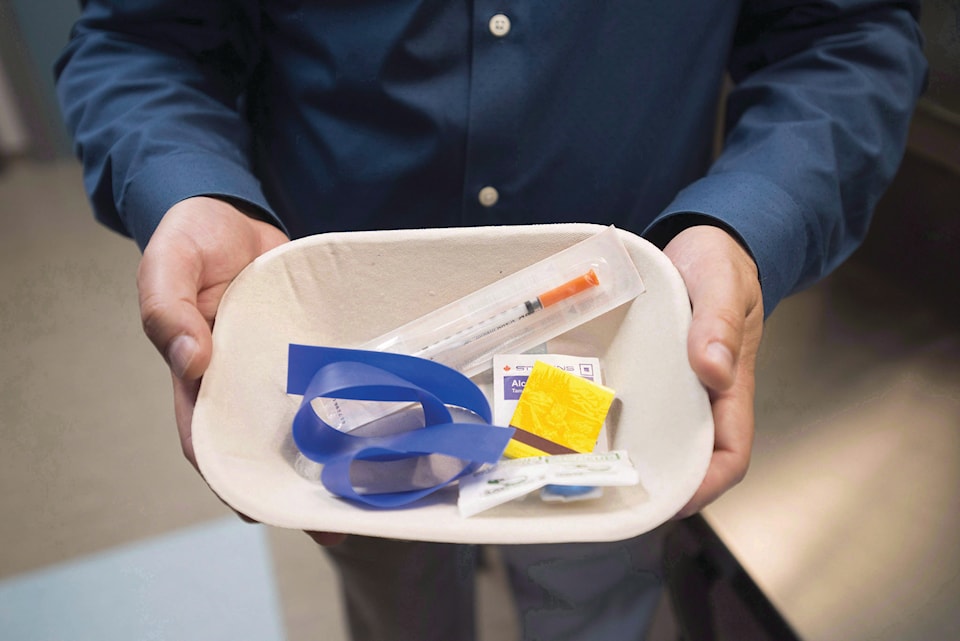Northern Health says the COVID-19 virus has had a significant impact on usage of both overdose prevention and harm reduction services across its service area.
Northern Health’s Medical Health Officer Dr. Rakel Kling told the Kitmat Northern Sentinel that the most observable impact has been a decrease in usage.
“I think the biggest impact that we’re noticed is there’s just been far fewer people coming to our overdose prevention site in Prince George,” Kling said.
She said this could be due to a number of reasons, including residents choosing to adhere to social-distancing guidelines put in place by the Province.
Kling said while it’s important to adhere to these guidelines, all of Northern Health’s harm reduction services, including their overdose prevention site in Prince George, are running with enhanced protocols in place to provide safety to both people accessing service at these locations and the employees who work there.
“We would absolutely advise that people continue to access their regular overdose-related and harm-reduction services that they would regularly access.”
READ MORE: Northern Health says it’s ready for a possible COVID-19 surge
Kling said all services related to the overdose crisis are either adhering to physical distancing or using personal protective equipment (PPE) when this is not possible. In addition, Northern Health is offering enhanced support to residents who may be symptomatic including access to testing and support finding housing.
“There’s a lot of really great work going on to support the overdose emergency and to prevent overdose deaths in light of COVID,” said Kling of the numerous workers across the health service area.
But while access to these services might be the most visible impact of the pandemic, Kling said it was not the only one.
A document released by the BC Coroners Service looking at illicit drug toxicity deaths for the first three months of 2020 paints a challenging picture emerging within the overdose crisis.
The number of overdoses in B.C. related to the use of illicit substances shot up from 77 in January and 70 in February to 113 for the month of March, the month in which the Province enacted most of its shutdown measures related to various sectors of the economy. Exceeding 100 deaths in a month has not occurred since March 2019.
In the Northern Health service area, there were nine deaths in January, four in February and nine in March. Of those 22 deaths, three occurred in the Northwest.
While the data is still relatively fresh, with most measures occurring in mid-to-late March, Kling said the indications have been clear: more people are dying.
“There’s certainly been increases in people experiencing overdoses as well as people dying from overdose-related deaths since COVID began,” she said, adding that social distancing means many are likely choosing to use at home. If you are using in such a setting, Kling said it’s important you aren’t alone.
Kling said another, harder-to-verify reason she has heard was that the actual makeup of what drugs people are consuming could have been indirectly impacted by COVID-19.
“This isn’t one that we’re able to prove easily, but just hearing anecdotally that there are changes in the drug supply right now because with borders shut to normal [traffic] drugs distribution routes are changing.”
Kling said the BC Centre for Disease Control recently released a drug toxicity alert warning for B.C. letting residents know there is increased toxicity in drugs circulating right now.
Kling said Northern Health’s overwhelming message was they are trying to encourage people to keep using the services they were before.
Similarly, residents are still being encouraged to familiarize themselves on Naloxone, which Kling said is still available across all communities within the healthcare provider’s service area.
“We very much encourage people to continue to get trained in naloxone and to get naloxone kits to reverse overdoses.”
Northern Health currently has the highest rate of illicit drug toxicity deaths (29 deaths per 100,000 individuals) followed by Interior Health (23 deaths per 100,000 individuals) in 2020. Overall, the rate in BC is 20 deaths per 100,000 individuals so far this year.
When broken down by service area the Northwest is the lowest of the three (15.6) while the Northern Interior is second (26.5) and the Northeast ranks first (49.5). The latter service area, which includes both Fort St. John and Fort Nelson, is currently the highest rate across the province (however these figures should be interpreted with caution as they only pertain to the first three months of 2020 and are subject to change).
Preliminary data from the BC Coroners Service report suggests that the proportion of illicit drug toxicity deaths for which fentanyl was detected (either alone or in combination with other drugs) was approximately 70 per cent in 2020, a decrease from 86 per cent in 2019. The report noted this data is subject to change as further toxicology results are received.
Kling said, while the decrease might look good on paper, they are still keeping an eye on what is going into drugs with potential distribution chain interruptions and what sort of combinations of illicit drug mixtures they see in the coming months.
“I think that’s a piece we’ll have to look into more before we make any conclusions.”
trevor.hewitt@interior-news.com
Like us on Facebook and follow us on Twitter
